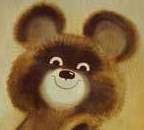The first thing that you have to realize, is that in a sandbox there is no such thing as "flavor text". You just pulled out original content from your imagination and everything in it has meaning in your world. Anything in it can become actionable information in the game that can be subjected to the game mechanics. For instance, a dusty red sofa in a littered empty dungeon room, can theoretically be traced down to the original manufacturer and tell us something about the original owners and how it got in the dungeon, telling the players something about the dungeon. More important is the so called flavor text that players generate about their character's background. If they say that they come from a family of circus performers, than there is a circus out there somewhere in the sandbox, where the player character's family is prominent, and if the player can get there, the family's shelter and resources can be available to them. Imagine the in-game consequences of the player character being the Son of Merlin. This will blow the economics of traditional D&D game of 3d6 gold pieces times ten to smithereens, but imagine the possibility for some high stakes gaming that this presents to a imaginative DM.
But I digress. There are three things that you can do immediately with your campaign setting tableau: (1) You can take the actual geographic places, and place them on the map. You can put your map on some existing campaign setting, say, Forgotten Realms, or you can build your own world. (2) You take the key NPC's that you came up with and give them places, taverns, guild halls, towers, castles, highways and byways, where these NPC's can be encountered. (3) You can take your story hooks, and also place them on the map via the Encounter tables, but mote on that later.
Now you have a tangible map for your campaign setting. You can Key it, generate descriptive text, and make encounter table, to make it playable in D&D. What makes OSR and D&D unique when compared to the other rpg's is that wilderness travel, Outdoor Adventure, is the big part of the game play, and even though you might be running a node network social encounter type of an adventure, you still crawl from one hex to another and roll for encounters when players travel from one location to another.
TO BE CONTINUED

What do you define as flavor text? One can call anything that we say, "Flavor Text". I like to set mood and tone, tell small stories about a place through details, and just have fun establishing a setting, because to me, setting is a character as well. If one goes into the castle of a tyrant, it should FEEL different than if one walks into the castle of a fair man.
ReplyDeleteAmong some DM's, there is a dismissive attitude towards the boxed description text in a D&D module, in other words, it has no impact on the game, as in, "DM reads the flavor text describing the room", or, "what follows is the flavor text describing..." I totally disagree with that. Anything that is read into the game has the potential to be used in the game itself. If players can follow up on the things you describe in small stories and develop things in them into actionable game events, then it is NOT flavor text.
ReplyDeleteI don't like to read boxed text. I'll read it, and try to describe what the box tells me in my own way. When I do read boxed text to the players its because I was being lazy, and quite often it ended up biting me in the ass, as the players will notice something in the text that I failed to see, because I was too focused on other things. I have identified it as one of my bad habits.
ReplyDelete